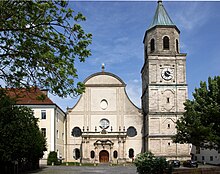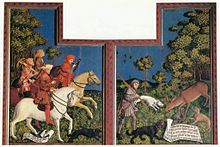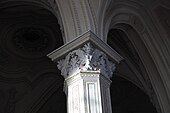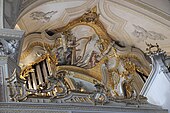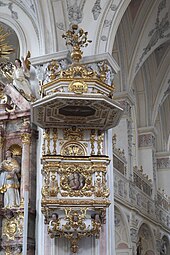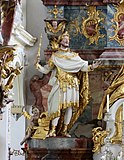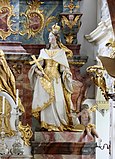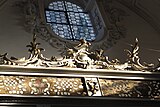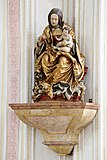Holy Cross (Polling)
The Catholic parish church Heilig Kreuz in Polling , a parish in Pfaffenwinkel , was built between 1416 and 1420 as the church of an Augustinian canon . In the first half of the 17th century the Gothic church was expanded with additions and chapels and redesigned in the Baroque style. The stucco decor from Georg Schmuzer , one of the first known members of the Schmuzer family of stucco workers and architects of the Wessobrunn school , has been preserved from this period . Another redesign in the Rococo style took place in the second half of the 18th century. The most valuable features of the church is also known as Tassilo Cross called Pollinger Cross , a high medieval panel cross. In addition to the patronage of the finding of the cross , the church also bears the title of Saint Salvator and is consecrated to Jesus Christ as Salvator Mundi (savior of the world). The church is on the list of protected architectural monuments in Bavaria.
history
According to a source from the 11th century, a family from the Huosi family founded a Benedictine monastery in Polling around 750 . In the 15th century the legend spread that the Polling monastery was founded by the Bavarian Duke Tassilo III. go back. While hunting, he is said to have chased a doe who carved a cross out of the ground where the monastery would later be built.
This first monastery was completely destroyed during the Hungarian invasions in the 10th century. In 1010, the Bavarian Duke Heinrich IV, who was crowned emperor as Heinrich II in 1014 , had a collegiate monastery built on the site , which was converted into an Augustinian canon monastery after 1100. A new church was built, which was consecrated in 1160 by Hartmann , the bishop of Brixen . The crypt under the Gottesackerkapelle on the other side of the Tiefenbach is still preserved from the previous Romanesque building.
In the 13th century, a popular pilgrimage to the Holy Cross developed and a church was built at the current location, which was consecrated in 1298. This church building was destroyed in 1414 and rebuilt between 1416 and 1420 in the Gothic style. In 1605 work began on building the new tower in the Renaissance style based on plans by Hans Krumpper , which, however, were not completed due to lack of funds.
Between 1621 and 1628 the provost Kilian Westenrieder had the Gothic hall church expanded. The choir was extended by three bays to the east and newly vaulted. A sacristy was added to the north and a chapel to the south, each with oratorios above. Chapels were also added to the long sides of the church and galleries were drawn in all around . In 1628 the bishop of Augsburg , Heinrich V. von Knöringen , consecrated the new building of the church. In 1733 the vestibule with the inscription LIBERALITAS BAVARICA (Bavarian generosity) was added to the west . Between 1761 and 1765, under provost Franz Töpsl , there was a further redesign and renewal of the furnishings in the late Rococo style .
architecture
On the south side of the west facade rises the belfry, begun in 1605 and remained unfinished, on which an octagon with a pointed helmet was placed in 1822. The church, built from Pollingen tufa , is a three-aisled hall with five bays . The pointed arcades, which date back to the Gothic era, are supported by towering octagonal pillars with baroque stucco decoration. The three-bay choir is the same width as the central nave and ends with a five-eighth end . The ceiling of the organ gallery is decorated with a fresco by Johann Baptist Baader from 1766 depicting King David playing on the harp.
Piece
The Pollingen collegiate church is one of the earliest churches to be decorated with Wessobrunn stucco . The stucco decor was made by Georg Schmuzer in 1625. The geometric shapes, the fields framed by ovules , the numerous rosettes and garlands point from the late renaissance to the early baroque . The capitals of the slender pillars are decorated with acanthus and, like the window frames, with winged angel heads.
Furnishing
- The table cross venerated in Polling, the Tassilo Cross, was made from spruce boards that came from a tree that was felled between 884 and 1018. The brittle wood, which was held together with the help of metal clips, was covered with horse skin around 1180, which was supposed to conceal the metal clips. It was painted with the life-size picture of the crucified Christ probably around 1230/40.
- Originally the cross stood on a side altar. Here was the so-called cross altar, a Gothic winged altar created around 1420 by the so-called master of the Pollinger panels , which is now kept in the Alte Pinakothek in Munich. On the wings of the altar are the scenes of the finding of the cross by Duke Tassilo III. and the elevation of the cross is shown. The Polling Cross stood at this altar until it was placed on the main altar in 1628.
- The high altar was created by Bartholomäus Steinle from 1623 to 1628/29 and redesigned into a stage altar by the Munich sculptor Johann Baptist Straub from 1763 to 1765 . Some of the putti and the figures of St. Ulrich , the patron saint of the diocese of Augsburg, and St. Augustine , the patron of the order, are still preserved from the original altar . The three female sculptures arranged around the tabernacle embody the divine virtues faith (with chalice), love (with heart) and hope (with anchor). Like the figures of Emperor Heinrich II and his wife Kunigunde , which were created around 1774, they come from Johann Baptist Straub or his workshop. In 1763 the Holy Cross was placed in the middle of the altar wall, surrounded by a halo of gilded copper, under a Rococo canopy.
- The two side altars, the Marien Altar and the Augustine Altar, were also created in 1625 by Bartholomäus Steinle and redesigned in the late Rococo style by Johann Baptist Straub in 1762/63. In 1763 Provost Franz Töpsl had eight new altars made of stucco marble erected in the side chapels .
- The pulpit from 1705 is richly gilded. The oil paintings on the pulpit represent the divine virtues of faith, hope and love, under the sound cover the dove is shown as a symbol of the Holy Spirit . The putti heads at the bottom of the pulpit indicate the meaning of the sermon through their facial expression of attentive listening.
- In the vestibule, two oil paintings from around 1735 remind of the legendary founding of the monastery by Duke Tassilo III. in the 8th century and its restoration in the 11th century by Emperor Heinrich II and his wife Kunigunde.
- The pews with their rococo cheeks were carved shortly after 1760.
- The grilles under the organ gallery and the grilles made of painted sheet iron with their carved attachments on the galleries of the choir and nave also date from the 1760s.
- The Madonna and Child sitting on a throne at the triumphal arch opposite the pulpit from 1526 is considered a major work by the Landshut-based sculptor Hans Leinberger .
organ
The organ was installed in 1768/70. The organ case comes from Franz Xaver Schmädl , the organ work from Dirlewang organ builder Johann Georg Hörtich . In 2004, the organ building company Johann Pirchner from Steinach am Brenner installed a new work in the old case.
literature
- Georg Dehio : Handbook of the German art monuments. Bayern IV: Munich and Upper Bavaria . 2nd edition, Deutscher Kunstverlag, Munich 2002, ISBN 3-422-03010-7 , pp. 980–983.
- Hans Pörnbacher: Collegiate Church Polling . Kunstverlag Josef Fink , 2nd edition, Lindenberg 2005, ISBN 3-933784-17-4 .
Web links
- Collegiate Church of Polling Municipality of Polling (accessed May 19, 2015)
- Holy Cross in Polling Catholic Parish Church Foundation Heilig Kreuz (accessed on May 19, 2015)
Individual evidence
- ^ Diocese of Augsburg
- ↑ List of monuments for polling (PDF) at the Bavarian State Office for Monument Preservation, monument number D-1-90-142-11
- ↑ Polling - place of pilgrimage and refuge of science, House of Bavarian History (accessed on May 19, 2015)
Coordinates: 47 ° 48 ′ 42.1 ″ N , 11 ° 7 ′ 54.1 ″ E
